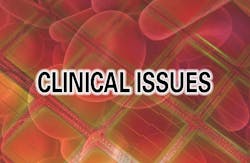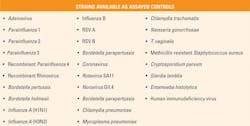Assayed vs unassayed controls: Is your clinical microbiology lab getting it right?
Last year, the Food and Drug Administration (FDA) issued a final order on the classification of assayed quality control material for clinical microbiology.1 It may not have made headlines, but this order has had an impact on the types of quality control materials clinical microbiology laboratories may employ.
Assayed quality control materials for clinical microbiology assays are considered devices by the FDA. This means that if assayed quality controls are used in a test system that measures test precision or detects systematic analytical deviations, then the FDA would classify these materials as special controls, or class II. The devices may consist of one or multiple microbiological analytes, which may be used with either qualitative or
quantitative assays.2
The FDA determined there are certain health risks associated with the use of these assayed quality control materials. For example, false negative results may occur if there is an assessment performance error. Improper or unexpected performance also may yield incorrect results. To provide a reasonable assurance of safety and effectiveness, the FDA added the special control classification to these materials, which places appropriate mitigation measures in place.
In the beginning
The FDA’s final order did not happen immediately. In December 2015, Bio-Rad Laboratories, Inc. submitted a request for classification of its Amplichek II device.3 According to an FDA letter dated March 28, 2016, the Amplichek II was “intended for use as an external assayed quality control material to monitor the performance of in vitro laboratory nucleic acid testing procedures for the qualitative detection of Methicillin Resistance Staphylococcus aureus, Methicillin Sensitive Staphylococcus aureus, Clostridium difficile and Vancomycin-resistant Enterococci performed on Cepheid GeneXpert Systems.”4 The product was not intended to replace manufacturer controls included with the device.
The FDA determined that the Amplichek II should be classified as class II with special controls. It was the first, or de novo, classification of this type of device. Future substantially equivalent devices of this type were to be known as, “assayed quality control material for clinical microbiology assays.”
Subsequent to the classification of the Amplichek II, the FDA added language to the Code of Federal Regulations, codifying the special controls that will apply to assayed quality control material for clinical microbiology assays.5 This codification order became effective on July 27, 2017, even though the classification was applicable at an earlier date.
Rigor for assayed controls
Assayed quality control material for clinical microbiology assays intended for use in test systems must apply for FDA approval through the class II (special controls) designation.6 The FDA will seek detailed information on the quality control material. This may include information on analyte concentration, expected values, analyte source, base matrix, added components, specifics on safety, handling, and instructions for use. A statistical analysis plan and study protocols that establish performance of the device are also required. This data is expected to outline the process for value assignment and validation, stability, precision, and reproducibility of the control. Significant differences between the quality control material and typical patient samples must also be shared, particularly where analytical error may occur or where assay performance may be impacted.
When applicable, the relationship between the control and a standard reference material or method should be shown. Similarly, traceability should also be identified, where germane.
The FDA requires a limiting statement be included with the device, noting: “Quality control materials should be used in accordance with local, state, federal regulations, and accreditation requirements.”7
Control types
Commercially available quality controls used in the clinical microbiology laboratories may be assayed or unassayed. Assayed controls have specific values and ranges assigned to them. Unassayed controls do not have assigned manufacturer values or ranges. Values for unassayed controls are determined by each individual laboratory, and statistical parameters must be established over time.
The FDA considers an unassayed control to be a 510(k) exempt device, or class I.8 Assayed control materials are now classified by the FDA as class II with special controls.
According to CLIA (Clinical Laboratory Improvement Amendments) Interpretive Guidelines, laboratories must establish (unassayed) or verify (assayed) the criteria for acceptability for all control materials.9
Patient samples also may be used as quality controls in some laboratory settings. While the use is permissible, quality control materials are not always commutable with the clinical sample. According to the World Health Organization (WHO) Laboratory Quality Management System Training Toolkit, if isolates from individual laboratories are selected for quality control, “they should be monitored closely to verify that reactions tested are sustained over time.”10 WHO emphasizes the importance of keeping “careful records for media that is prepared in the laboratory.”11 The New York State Department of Health’s Clinical Laboratory Standards of Practice notes that quality control stock cultures should be “standardized in a manner that minimizes the opportunity for contamination or alteration of relevant characteristics.”12
Controls labeled for “Research Use Only” are not permitted for clinical use. As stated in regulation 21 CFR 809.10, laboratory products “not represented as an effective in vitro diagnostic product,” must state that it is “For Research Use Only” and “not for use in diagnostic procedures.”13
On the market
Even though the FDA order regarding assayed quality controls for clinical microbiology is still relatively new, there are assayed controls available on the market now. The availability of these controls is likely to increase as the use of molecular kits and standards grow. Only assayed quality control materials may be listed with specific, related instruments. In addition to the Bio-Rad Amplichek II, Table 1 lists the strains among those available on the market as assayed controls.
The choice of controls is a decision for each laboratory to make. For regulatory, accreditation, and quality assurance purposes, it is important for laboratories to understand the distinctions between assayed and unassayed controls for clinical microbiology assays.
REFERENCES
- Medical Devices; Immunology and Microbiology Devices; Classification of the Assayed Quality Control Material for Clinical Microbiology Assays, 82 Fed. Reg. 143 (July 27, 2017)
- Ibid.
- Ibid.
- Letter from Director of the Division of Microbiology Devices at the Food and Drug Administration to Bio-Rad Laboratories. March 28, 2016. https://www.accessdata.fda.gov/cdrh_docs/pdf15/DEN150058.pdf (Accessed on September 27, 2018).
- 21 CFR 866.3920.
- Medical Devices; Immunology and Microbiology Devices; Classification of the Assayed Quality Control Material for Clinical Microbiology Assays, 82 Fed. Reg. 143 (July 27, 2017)
- Ibid.
- Ibid.
- State Operations Manual. Appendix C – Survey Procedures and Interpretive Guidelines for Laboratories and Laboratory Services. Centers for Medicare and Medicaid Services. §493.1256. Rev. 166. March 3, 2017.
- Laboratory Quality Management System Handbook. World Health Organization, et. al. 2011. p.95.
- Laboratory Quality Management System Handbook. World Health Organization, et. al. 2011. p.99.
- Clinical Laboratory Standards of Practice, Part 2. New York State Department of Health. Wadsworth Center. Clinical Laboratory Evaluation Program. June 2014. p.103
- 21 CFR 809.10


